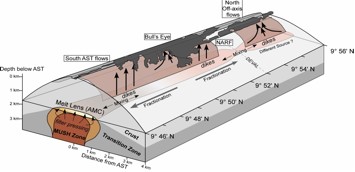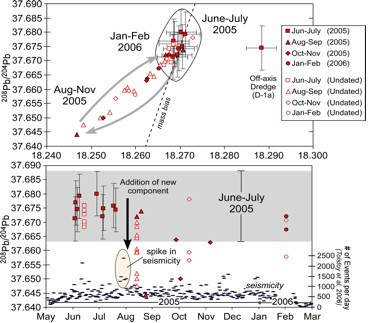Goss
Geochemical characterization of lavas from the 2005-06 eruption along the EPR (9°46’-56’ N): Implications for melt composition, eruption driving forces, and mantle heterogeneity
A. Goss¹*, M. Perfit¹, K. Rubin², G. Kamenov¹, I. Ridley³, S.A. Soule⁴, & D. Fornari⁴
Corresponding author: argoss@ufl.edu
¹University of Florida, Department of Geological Sciences, Gainesville, FL, 32607
²University of Hawaii, Department of Geology and Geophysics, Honolulu, HI, 96822
³USGS, Denver, CO 80207
⁴Woods Hole Oceanographic Institution, Woods Hole, MA 02543
Abstract:
Fundamental questions still remain regarding the spatial and temporal thermo-chemical evolution of fast spreading centers, including the 8°-11° N East Pacific Rise (EPR). In 2005-06, axial and off-axis fissure eruptions occurred along a ~18 km-long (9° 46’-56’ N) segment of the northern EPR within the R2K ISS. This event marked the first observed repeat eruption at a mid-ocean ridge as 2005-06 units buried flows from smaller eruptive events in 1991-92. In general, 2005-06 lavas have typical N-MORB geochemical signatures with strongly depleted incompatible element patterns. Compared to 1991-92 lavas, 2005-06 lavas are slightly more evolved and exhibit evidence for ~ 15 % fractionation of plag, ol, and cpx from a more primitive parental melt. Spatial geochemical differences show that lavas from the northern and southern limits of the eruption are on average the most evolved, and that chemical variability is preserved over decadal time scales. Sr, Nd, and Pb isotopic ratios for axial and off-axis lavas fall within larger isotopic fields defined for 1991-92 lavas from the 9°-10° N EPR. Geochemical data from the 2005-06 eruption are consistent with upper crustal processes (e.g., fractional crystallization and magma mixing) operating on decadal scales within the AMC. Products of an off-axis fissure eruption are chemically similar to northern axial flows, though some northern lavas may also contain a distinct melt component not observed in the main suite of 2005-06 lavas. These findings suggest the 2005-06 lavas likely represent differentiated and mixed residual liquids from the 1991 eruption and that the eruption was not catalyzed by the injection of more-primitive mantle-derived basalt into the AMC. Instead, we suggest the eruption was driven by the percolation of fractionated magmas from the mush zone into the melt lens over decadal scales facilitated by local and tectonic extensional forces applied to the neovolcanic zone.
Contributions to Integration and Synthesis:
Integration of the geochemical data from the 2005-06 EPR eruption with various other data sets is critical for understanding the entire active ridge system at the EPR ISS. A relationship exists between (1) our Pb isotopic data, a traditional indicator of mantle composition, (2) the ultra-high precision 210Po ages with the resultant spatial/temporal models for the eruption (Rubin et al., 2008 and unpublished data), and (3) the published pre-eruption microseismicity record (Tolstoy et al., 2006). Regardless of location, all basalts erupted during June-July 2005 exhibit a narrow isotopic range that contrasts with statistically-resolvable differences in younger lavas from August-November 2005. Such isotopic variability most likely results from intra-eruption differences in mantle-source chemistry not evident in the spatial distribution of lavas. Moreover, the abrupt change in the isotopic signature is immediately preceded by a increase in recorded seismicity. The final lavas to erupt in early 2006 revert back to having the original Pb isotopic signature seen in lavas from the first two months of magmatic activity. The significance of such temporally-constrained isotopic variability remains enigmatic, but we speculate that an isotopically-zoned AMC reflects subtle, yet intrinsic, variability within the sub-ridge depleted mantle. Mechanical disruption and tumescence of this AMC in August 2005 resulted in the eruption of isotopically distinct melt. Integration of these data with thermal and chemical records of hydrothermal vents as well as other geophysical data may reveal more information regarding the short temporal evolution of the EPR AMC.
Figures:
Figure 1. Model of the 9°46’-56’ N EPR showing tectonomagmatic features. Outline of the 2005-06 eruption is from Soule et al. (2007). Goss_fig1.jpg
Figure 2. Top: Graphs showing ²⁰⁸Pb/²⁰⁴Pb vs. ²⁰⁶Pb/²⁰⁴Pb ratios for ²¹⁰Po-dated (Rubin, unpublished data) and undated basalts from the 2005-06 eruption. Undated samples were given ages based on proximity to dated samples. Arrows show temporal trends in the isotopic data. Lower: ²⁰⁸Pb/²⁰⁴Pb ratios vs. time showing the # of seismic events/day (Tolstoy et al., 2006). Goss_fig2.jpg


